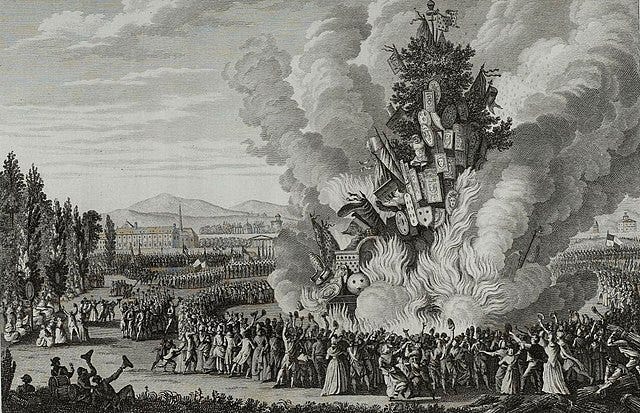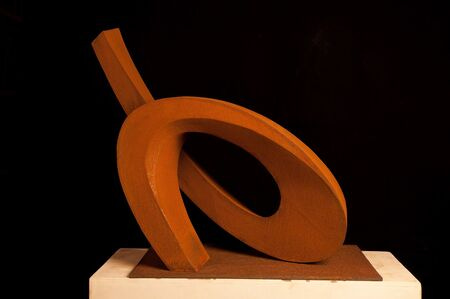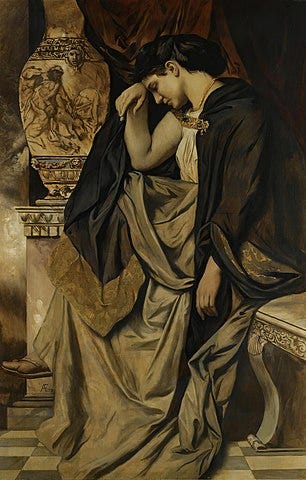
Dear Gentle Readers,
Happy Bastille Day!
I promised to talk to you about minimalist and maximalist writing, using as usual my own work in progress as well as other people’s novels. The issue is that I’m torn, always, between a love of the simple and austere in style and content, and a tendency towards diversity, eclecticism, and lyricism.
I’ll just quote myself from last week to remind you of the issue:
If you look at my home you’ll see, I’m afraid, the same conflict between minimalism and maximalism. Over the years, I’ve settled for this process of writing a sentence, adding things into that same sentence in the process of editing it over and over, and—the bit I didn’t mention yet—then removing everything that feels like excess, trying to get back to minimalism. I think this gives something of a middle-ground: clean but lively prose. Still, there is a tension here I’m not sure how to resolve […]
It’s not just a matter of style, but of content, too, of digression and how much contributes to the story and how much detracts and what kinds.
The question of style is fundamental to me, but let’s talk about style within digressions for a bit (if you’ll allow me to digress).
On different styles of digression
Minimalism can include minimal and focused plot lines as well as style, producing a concise and spare story told in a concise and spare way, such as a Raymond Carver or Ernest Hemingway short story, or an action focused novel by the just-deceased Cormac McCarthy.
But minimalism can be just an issue of style, such that you can digress in a minimalist way—with the precise and staid yet cumulatively kinetic language of a W.G. Sebald or Jon Fosse, or Samuel Beckett, for whom consciousness, portrayed in language, is fragmentary but digressive. Or in a maximalist one, the text lush with florid language and metaphor—as per James Joyce or Vladimir Nabokov, who noted that “you can always count on a murderer for a fancy prose style"—or making making wild leaps and telling stories within stories, like Gabriel García Márquez or Salman Rushdie. Fleur Jaeggy wrote short stories and novellas so slim they should be called novellinas or novelettes (I read my first some time ago but am now zipping through the rest, perfect for carrying around on transit or in waiting rooms), and yet within each chilly, austere sentence (the publisher describes her style as austere yet voluptuous) there are sudden shifts to apparently disjointed topics and an accumulation of digressive detail that manages to be Romantic or even, somehow, lush—while retaining the minimalist feel of a haiku.
Perhaps the opposition of minimalism and maximalism is wrong, then, given that each writer’s style and the degree to which they seem to digress from the main arc of the story or the essential information that needs to be conveyed in each sentence is really a mix of many stylistic influences and choices about what to reveal. Here, for example, are various takes on Sebald’s hypnotic, slowly revealing, cryptically addictive style, which most readers probably wouldn’t actually give the label ‘minimalist’ at all:
Ornate, archaic, stately sentences—but also ‘haiku'-like’ and ‘musical’
And this is a really interesting piece on it, in which the author contrasts the ‘steady and unrelenting tempo’ of Sebald’s elegant, flat, precise sentences, deliberately devoid of ‘aesthetic elaboration’, that make up a ‘self-sufficient and closed system’, to the uncertain tempo of Marcel Proust’s equally long and digressive and multi-clausal but more ‘ambulatory’ sentences, in which he elaborates freely and wildly with images external to the source material.
I wrote my note about the ‘minimalist feel of a haiku’ regarding Fleur Jaeggy’s work before noting the comparison of Sebald’s style, in the second-last essay there, to the mysterious and limpid feel of a haiku. I feel like, given similarities between these authors’ precise, chilly, haunting tone, this offers some support for my contention that there is something pared-back and essentialist about every step on the great spiral staircase of each long, ruminative, digressive sentences.
Note that style is sometimes conflated with content or narrative strategy, when it should further include diction, tone, structure, word choice and everything else that gives one’s writing its unique voice, its feel that only you could have written it.

Reduction under pressure
I very often enjoy novels of adventure or of the inner transformation that comes when a single character is placed under extreme pressure, as in a desert island survival story.
Keep reading with a 7-day free trial
Subscribe to Live More Lives to keep reading this post and get 7 days of free access to the full post archives.




